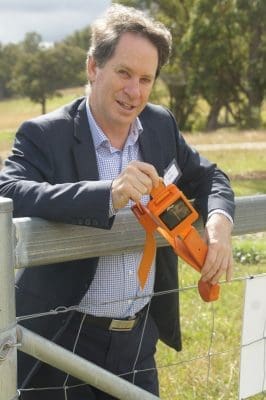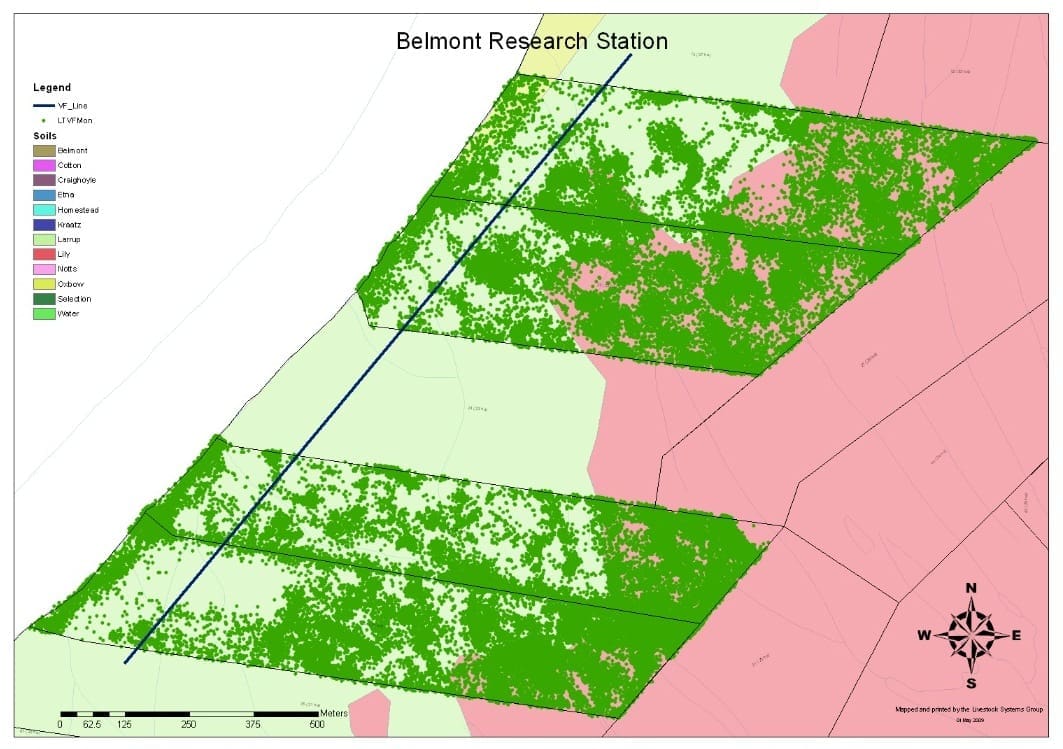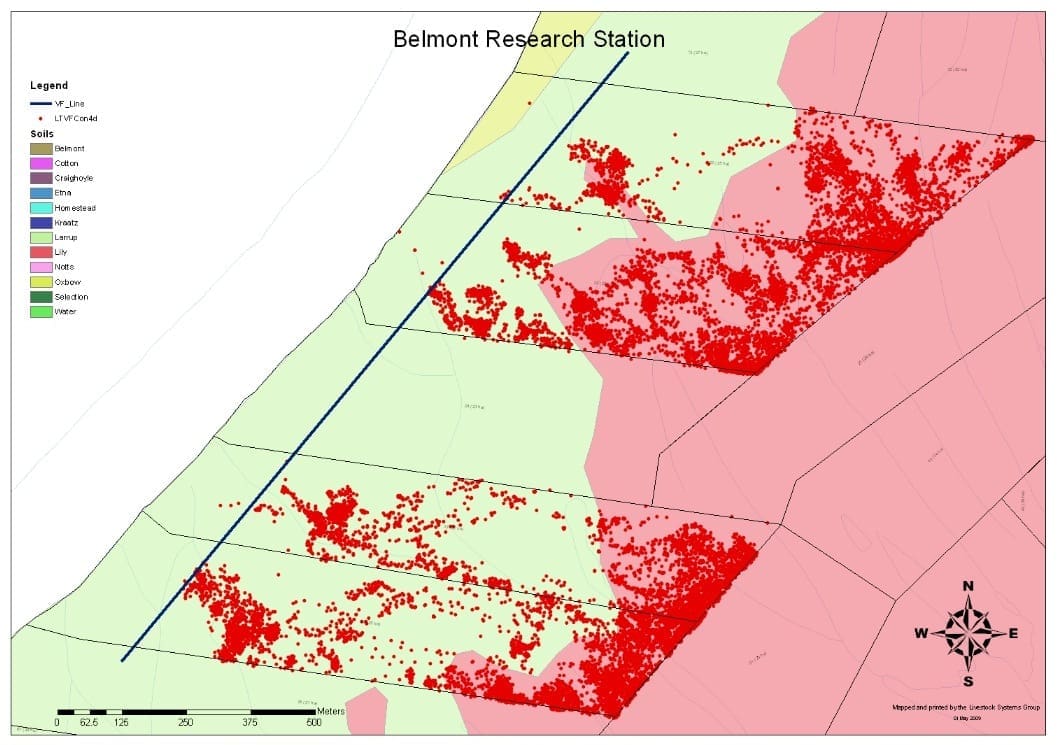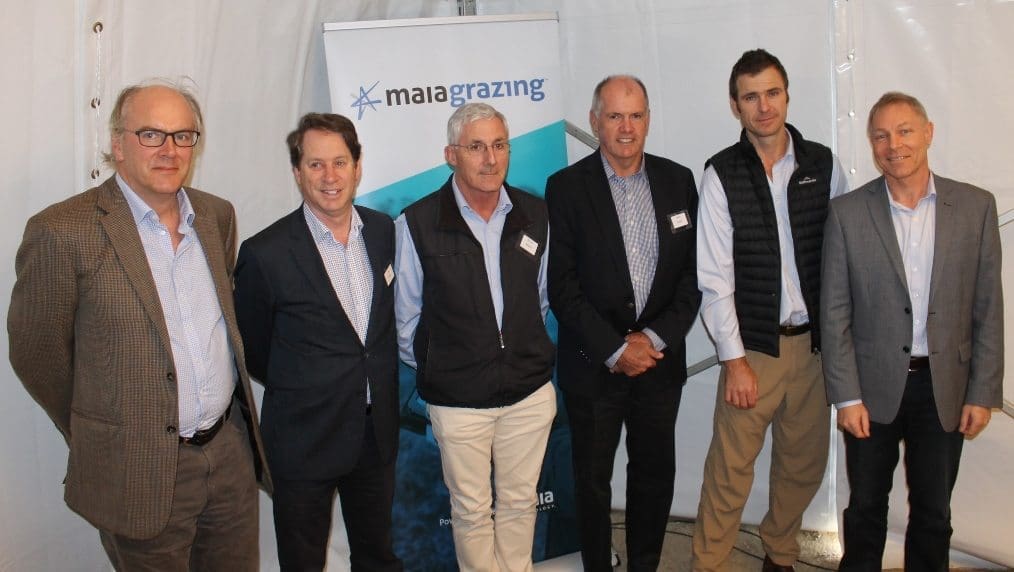THE company behind the development of collar-based virtual fencing technology plans to release a prototype version of its product around mid-year, in the next stage towards commercial launch.
Speaking at an ag-tech conference last week, Agersens chief executive Ian Reilly said the company’s eShepherd technology would be released in prototype form in June, and then gradually rolled-out in commercial validation trials across Australia in target markets.
Australia’s first ag-tech event specifically for grazing was hosted by grazing management technology developer Maia Technology at the University of New England’s SMART Farm near Armidale on Thursday, bringing together experts to discuss the emerging revolution in livestock management and supply chain technologies. The event also served as the official launch of Maia’s new decision support tool, MaiaGrazing.

Ian Reilly from Agersens, with an eShepherd virtual fencing collar which will be released as a prototype in June. Click on image for a larger view.
Agersens’ eShepherd product is an automated grazing control tool developed by CSIRO, enabling livestock producers to fence, move or monitor their livestock location using their smartphone or tablet.
The system uses animal-friendly patented training software. GPS and other sensors are employed to closely monitor the animals’ behaviour and each animal is trained to respond to an audio sound that signals the presence of the ‘fence-line’ boundary.
Mr Reilly grew up on a cattle and sheep enterprise in northeast Victoria before embarking on a career as an engineer in emerging technologies development, launching Agersens in 2014.
Visiting a property in Central Queensland some years ago, it struck him in conversation with the manager about the challenges faced in the business that automation of the process of grazing control would help improve and optimise productivity on the property.
Agersens connected with the CSIRO and licensed the commercial development of the technology.
Mr Reilly highlighted the challenges of rising costs in cattle production, labour issues, and the need to increase scale for greater efficiency, while keeping costs as low as possible, improving traceability and moving towards greater sustainability.
The eShepherd system uses a collar fitted to animals (see prototype example in photograph above) containing a GPS chip, and a ‘training’ algorithm and training technology developed by the CSIRO, now licensed to Agersens.
The animal is conditioned to respond to an audio cue/electric stimulus as it approaches the virtual fenceline. The collar also contains various other movement monitoring technologies that allow the user to understand what the animal is doing and its behaviour at any time.
The collars in their current form are designed to operate for five to ten years, using a solar-panel powered rechargeable battery.
The eShepherd system allows a producer to use a smartphone or tablet to create a ‘virtual’ fence perimeter, sent via the Cloud to a base station on each property. The base station, with a 5-30km range, depending on topography, (repeater stations can be installed) is used to send instructions to each collar fitted to animals.
“Essentially the technology works much like a mobile or GPS-based electric fence,” Mr Reilly said. “As the animal approaches the designated boundary, it receives an audio cue. If it stops, nothing happens, but if it keeps moving in the direction of the boundary, it will move into the virtual fence, and receive an electric stimulus.”
Animals learned to be guided by eShepherd within a two to three-day period of training, he said.
“The electric stimulus is nowhere near as powerful as the jolt in an electric fence, but it is enough to make life uncomfortable, without causing any lasting harm,” he said.
A key issue is that the system does not need a mobile phone network across the property, but it does need an internet connection for the base station. That could be via sim-card, landline from the farm, satellite or other means.
Essentially by moving the GPS sensors, cattle can be relocated from one area to another.
“Using virtual fencing, a stock manager can effectively create any number of fences, anywhere, of any shape…. and change them whenever he wants”
“Using virtual fencing, a stock manager can effectively create any number of fences, anywhere, of any shape. It can be conformed with the topography or land type, to create a paddock or grazing areas for stock today, and then change it and move them to a different location tomorrow. And depending on how they graze a particular area, they could be moved out of a more heavy grazed area into a less heavy grazed area, for maximum pasture utilisation,” Mr Reilly said.
“One of the primary benefits is to enable producers to automate rotational or cell grazing programs. Regardless of whether it is an extremely large grazing operation in the Northern Territory or a hobby farmer with a few hectares, they will be able to utilise the technology to move cattle as desired, and do it remotely.”
“Some producers using set stocking tell us they estimate they are currently getting 40pc pasture utilisation. Through using this tool, controlling their grazing applications better means some may be able to get 80pc or better utilisation, they say.”
“There is significant low-hanging fruit there, that’s available, increasing productivity while decreasing land damage through over-grazing.”
Mr Reilly said in large grazing applications, which were likely to be the eShepherd’s first target market, there was significant opportunity to apply both the means to improve productivity, but also to cut costs.
“One of those cost factors is mustering – in the ability to muster 100pc of stock, to know every week how many stock you have, and where they are. It will potentially reduce labour cost, and also reduce the cost of insurance and workplace health and safety costs that come with that.”
The ability to muster cattle ‘slowly’ using eShepherd would reduce stress and weight loss, and provide an accurate number in the mob when ordering transport, he said.
Beyond the ability to manage and move cattle remotely, the system provided potential benefits in recording and measuring data on individual animals.
“We think it provides enormous opportunities for downstream applications, some of the immediate ones of which include simply knowing how many stock are a on hand, and where they are, but also for detecting theft, and detecting where animals have died, or where they may be if they are lame, bogged or suffering illness, where movement becomes limited,” Mr Reilly said.
Accumulating that data and feeding it back provided the opportunity to apply analytical techniques to derive decision-support data and information that can be provided directly to the producer.
“But it could also be sent to others in the value-chain. We’ve already had discussions with banks who are attracted to the idea of bringing farms online, to provide greater security over stock numbers as an asset. Greater asset security could possibly deliver lower premiums for insurance companies.”
Riparian applications
A key early trial of the concept took place at CSIRO’s Belmont research station near Rockhampton, where river frontage provided an opportunity to test the system for management of riparian areas.

Paddocks before the activation of the eShepherd system, with grazing distribution in green. Fitzroy River frontage to the northwest.

Grazing distribution in red after the eShepherd technology was activated. Blue line denotes virtual fencing boundary. Click on both images for a larger view
As these plot maps show, the system effectively kept stock off the river frontage, once activated, and an alternative watering point added in each paddock.
The need for effective riparian (waterways) fencing was a very significant one in Australia, on erosion and land management grounds, Mr Reilly said. For this reason part of the funding for the project has come from the Victorian Catchment Management Authority.
Beef Central asked Mr Reilly if the collars could be fitted to just a portion of a mob of cattle, and still exert some level of control, due to the bovine herding instinct.
“It’s a question that frequently arises, but at this stage we don’t have any recommendations to do that. Some of the issues around that are understanding who the leaders and the followers in a mob are; and social groups in cattle, once formed, can change.”
Questioned about costs of installation, Mr Reilly suggested a figure of about $100 per head for a collar installation and supporting technology, but volume discounts would apply for larger operators, and he was confident the price would continue to decline once the collars went into large-scale production.
“Hopefully some time in 2018 we will be in that position,” he said.
Agersens is also working on smaller ear-tag concepts as an alternative to collars, but the more compact form is still some way off. Mr Reilly said the company did expect an eartag version to emerge as technologies improved, which would have particular application for smaller animals like sheep and alpacas.
Standing room only at ag-tech grazing event
Australia’s first ag tech event specifically for grazing was hosted at the University of New England’s SMART Farm near Armidale on Thursday.
Hosted by Maia Technology, the ‘Australian Ag Tech in 2017 – Precision to Decision for Grazing’ event featured speakers including Australian Farm Institute executive director Mick Keogh; veteran beef enterprise consultant Bill Hoffman; director of Resource Consulting Services Dr Terry McCosker; UNE SMART Farm’s Professor David Lamb; CEO of Agersens Ian Reilly; Pastures from Space Director Dr Simon Abbott; Australian Meat Industry Council general manager Patrick Hutchinson; Willmot Cattle Co’s Stuart Austin and Maia Technology co-chairman Alasdair MacLeod.

Guest speakers at Thursday’s Armidale ag-tech seminar included from left, Maia Technology’s Alasdair MacLeod, Agersens’ Ian Reilly, Pastures from Space’s Simon Abbott, AFI’s Mick Keogh, Maia’s Bart Davidson and Peter Richardson.
Mr Macleod said the event was held to showcase the significant ag-tech innovation that exists in the grazing sector, and discuss how it can be harnessed to increase productivity and profit.
“Until now, grazing has very much been the poor cousin to cropping when it comes to harnessing technology to maximise performance,” he said.
“We wanted to showcase what’s available now to graziers, but also discuss how these new technologies and systems can set new standards underpinning food safety, food traceability and environmental sustainability for the industry, and explore Australia’s very real opportunity to become a leader in the convergence of ag-tech and grazing.”
Australian Farming Institute executive director Mick Keogh, said it had been suggested that the digital agricultural would be the next major agricultural revolution.
“I tend to agree with this. I think it’s becoming very clear that ag tech will transform the way that farm businesses and their supply chains operate in the next few years, and that will open up major opportunities that will enable the sector to grow. However, those who are not prepared for change run the risk of becoming victims of that change,” he said.
NSW beef management consultant Bill Hoffman, from Hoffman Beef Consulting, said better grazing management decisions could help achieve the best outcomes for productivity and profit.
“Decision support technology is the next big king-hit for grazing. There is an amazing range of current and emerging technology including MaiaGrazing and others; the challenge is how we make it all fit together to get the most out of it,” Mr Hoffman said.
Strength in ‘measuring grass’
Ebor (northern NSW) cattle manager Stuart Austin, from Willmot Cattle Co, is using the MaiaGrazing package, and says its greatest strength is the fact it ‘measures grass.’
“We measure every aspect of our business – you can’t manage what you don’t measure. If we can measure the fundamentals, (soil, rainfall, grass, kilos of beef produced and income generated) we can maximise productivity and profitability whilst regenerating our landscape at the same time.
“Maia is valuable to us because we are fundamentally grass farmers and Maia measures it. It allows us to plan, monitor and manage, and see the rest period for every paddock on the property. We can match our stocking rate to carrying capacity, and productivity, people and environment are well and truly covered,” Mr Austin said. More on Mr Austin’s presentation in an upcoming article.
Australian Meat Industry Council processor group general manager Patrick Hutchinson, told the meeting the opportunity for data relied upon how it was used.
“Programs like MaiaGrazing are giving us confidence as an industry that data being captured can be used effectively and efficiently by producers. This is where we see a great opportunity for a supply chain approach in managing and using data, because if data is being generated and the industry is investing in it, we want to be sure that we can make full use of it for producers and in the supply chain,” he said.
The launch of Maia Technology’s MaiaGrazing at the event demonstrated what technology does best: reach beyond the capacity of the human brain to provide the basis for better decisions.
MaiaGrazing gives graziers a position statement on their farm’s current situation, and its productivity outlook, to support decisions about how stock and pasture are managed for the coming days, weeks and months. That statement is built from data drawn from rainfall, animal and pasture growth models, and from a farm’s own management patterns, to provide a unique picture of future capability.
Producers from NSW and Queensland attending the Armidale event were given a demonstration of the decision support technology, as well as eShepherd virtual fencing and remote pasture management from Pastures in Space.
“Stress in agriculture comes from not knowing what comes next – if we can improve this using decision support technology, we remove the stress,” Maia Technology CEO Peter Richardson said during the event.
“When you know what’s coming, it’s a different story. This is what MaiaGrazing helps graziers to do and we were delighted to have a full house at today’s event to showcase how this works.”
Bringing together other ag-tech providers
Maia Technology’s vision is to create an ‘ecosystem’ where third parties can collaborate using the existing platform and data captured via MaiaGrazing, to offer a truly integrated system and approach for grazing.
“We recognise the power of the data we are collecting from producers – we want to bring together other ag-tech providers and products so that together, we can provide a one-stop solution for grazing management, instead of producers buying into lots of different widgets and systems,” Mr Richardson said.
He said MaiaGrazing’s unique power lay in its ability to learn from the past — not just from universal data sources, like historical climate patterns and pasture growth models, but how an individual property is grazed.
“It’s not just a number capturer or cruncher – it’s a way to look forward and make the best decisions based on learning how a specific property performs,” he said.
- For more details on Maia Technology’s new MaiaGrazing platform, click here.
- For more details on the eShepherd virtual fencing program, click here.



HAVE YOUR SAY